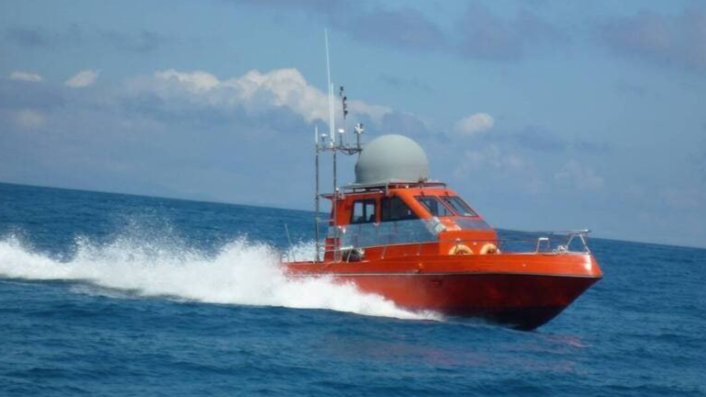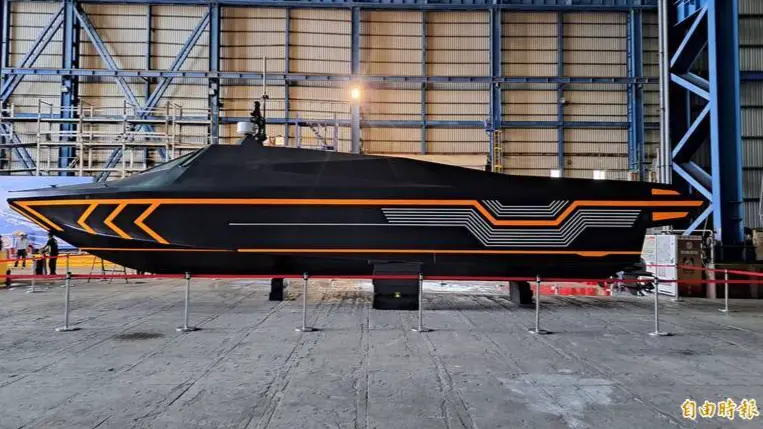Taiwan’s vision to have a fleet of unmanned boats is also consistent with the Overall Defense Concept, which calls for developing asymmetric capabilities before China
A Taiwanese shipbuilder has unveiled an “unmanned boat” as a “universal test platform” that has “military applications” if “imagination” allows. A report by Liberty Times quoted officials from the developer, CITIC Shipbuilding, who indicated Taiwan’s private industry is being roped in to bolster similar efforts by government arms makers in the direction.
CITIC’s “unmanned boat, with a fully loaded displacement of less than 20-tons, has a wide range of potential uses.” “In addition to being able to return home on its own, it may also be used for purposes such as mine clearance.”
It would be pertinent to note that another multipurpose USV (Unmanned Surface Vessels) developed by the NCSIST (National Chung-Shan Institute of Science of Technology) is remotely controlled and has been inspired by Ukraine’s use of USVs in the Black Sea. Kyiv has successfully sunk many Russian warships since mid-2023.
While the report did not identify the boat’s designation, posts on a few Telegram channels, claiming to originate from Weibo, said the developer calls it FJ-002. This however is not yet certain.
Interestingly, Taiwan’s vision to have a fleet of unmanned boats is also consistent with a previous military concept tabled by a former military chief, still being debated within its strategic and academic circles. Moreover, the boat’s declared autonomous capability also potentially counteracts how China plans to tackle such threats.
New USV
CITIC unveiled the USV while delivering the Anping-class frigate to the navy. Han Bixiang, CITIC Shipbuilding’s president, while saying their projects are “ahead of schedule,” they are also “developing unmanned ships.” “An avant-garde all-black painted boat was placed at the ceremony site, which is the unmanned boat being developed by CITIC Shipbuilding.”
The “universal test platform” has a total length of 16.5-meters, is 3.8-meters wide, a draft of about a meter, touch more than 30-knots (about 55.56-km), and has an endurance of more than 300-miles (about 555.6-km) with 1,300-liters of fuel.

The boat can “sail autonomously in the absence of GPS and communication equipment,” and can “return home through its own computer calculations.” The platform has “multiple uses” like “minesweeping, minelaying” and even “suicide attacks.”
A project like this could be used to test and validate various sensors, electronic communication equipment, jammers, ELINT/EW (Electronic Intelligence/Electronic Warfare) technology. Most importantly it allows experimenting with and refining autonomous guidance, control software, and algorithms.
Unmanned systems having little, if not any, remote human intervention protect platforms against EW, that aim to sever the radio or satellite link with the controller. Whether technologies perfected on this USV will be rolled out on existing projects, or this vessel itself being chosen for mass production, remains to be seen.
Taiwan Implementing ODC (Overall Defense Concept)?
Taiwan’s plan is also largely in line with former Taiwanese Chief of Defense Staff Admiral Lee Hsi-ming’s ODF (Overall Defense Concept) doctrine. This calls for acquiring thousands of low-cost expendable drones, missiles, unmanned naval systems, fast-attack craft, missile boats, and mine-layers to fight a prolonged war at a strategic level in a multi-layered campaign of attrition.
Naturally, the concept does not favor the purchase of large capital and unconventional systems like fighter jets, tanks, or artillery guns, which would be ineffective against the multifaceted threats posed by the PLA (People’s Liberation Army) Army, Navy and Air Force.
Opinions have differed only on the proportion of such asymmetric systems to large traditional weapons and their core utility. Nevertheless, the serial production of a modular, multi-function and autonomous USVs poses the first significant threat to the PLA Navy warships and amphibious landing vessels that are expected to enforce a blockade around the island.
While not expected to completely sink the PLAN or hand it a decisive defeat, the ODC is more oriented towards disrupting and complicating Chinese naval operations long enough for help to arrive from allies like Japan or the US.
Another Drone Boat Project
In Nov. 2023, Taiwan’s NCSIST (National Chung-Shan Institute of Science and Technology) unveiled an “uncrewed target ship,” which it plans for “mass production” by 2026 after it passes “military tests,” according to Taipei Times. The USV, which “resembles a speed boat,” is described by the NCSIST as a “target ship system.”
Subsequent reports by March said that the military was considering 200 units of the system. “The government began developing applications of uncrewed vehicles after Ukraine used craft that can be remotely controlled to destroy Russian vessels,” the report added.
It primarily has electronic warfare (EW), electronic intelligence (ELINT), surveillance, reconnaissance, network-centric communication, and targeting data relay technologies. These can be used to simulate targets of radar, sonar, and electronic signatures for Taiwanese military crews to train on.
The target craft system is an “unmanned maritime vehicle” that also appears to possess semi-autonomous capabilities. It has “functions” like “remote control, pre-planned routes, and real-time video transmission,” with devices like “radio frequency simulators, radio frequency interference simulation systems, heaters, flame launchers, and radar signal reflectors.”
“The system can simulate radio frequency signals, interference signals, thermal radiation signals, and scan cross-sectional areas of maritime targets. Multiple sets of target craft systems and project training courses would be combined in the military training to simulate various scenarios and effectively measure the weapon performance,” the institute said.
It can also perform combat and combat support roles. “The integral radar, weapons, sonar, and other modules in the target craft system can also be expanded to perform near-shore defense, attack, mine detection, submarine detection, and other tasks,” the NCSIST website said.
To counter “China’s military threat,” NCSIST plans an NT$812 million (US$25.14 million) investment to build two uncrewed attack craft with different sizes and bomb loads. The remote guidance and control distance of the two uncrewed attack craft would be increased from 60 to 70 kilometers.
‘Drone Boats Useless Before China’
Chinese experts have however dismissed the NCSIST vessels’ military utility. They appear to validate the core concept, but argue how Beijing’s military and industrial superiority nullifies the USV’s impact. SCMP (South China Morning Post) quoted a report from CCTV (China Central Television) where military expert Shao Yongling said the PLA “would be able to disable all drone bases in Taiwan before launching any naval operations.”
“Most of Taiwan’s military installations, such as weapons depots including its airports and harbors, would be targeted in the first wave of strikes,” she said.
Another military observer Wei Dongxu told CCTV that even if the drones survived, they only had a range of 70-km and rely on signal relay stations, which are vulnerable to the PLA’s electronic jamming and interference. The fragile boats are also vulnerable to even small and medium-calibre guns of the “PLA’s maritime combat system.”
The Chinese analysts’ projections are consistent with previous analysis in The Aviationist and concept videos by Beijing’s military itself about what a military invasion of the island might look like. The move would be a sudden, large multi-front coordinated combined arms maneuver to overwhelm Taiwan’s military and political leadership.
That video by China’s ETC (Eastern Theater Command) showed dozens of surface-to-surface missiles, MLRS, land-strike missiles by PLAN warships, ALCMs (Air-Launched Cruise Missiles) from J-10, Su-30/J-16, streaking towards Taiwan and landing on its southern, northern and western tips.
Strikes on such supporting infrastructure make any remaining forward combat units, like aircraft, ships (or in this case sea drones), futile as they have no bases to return to even after successful tactical engagements. If Taiwan uses remotely controlled USVs, the control stations hosted at these very naval facilities would come under attack, leaving nothing to operate them with.









